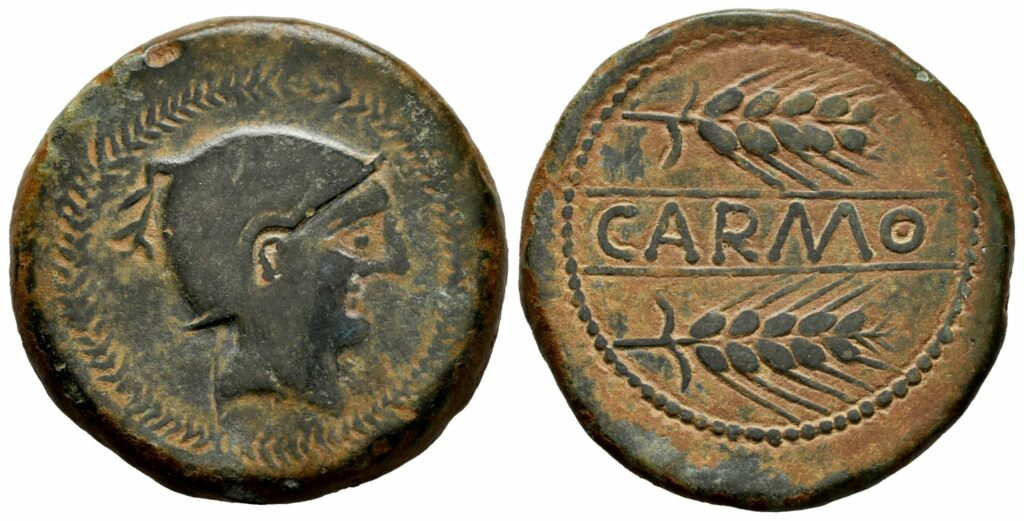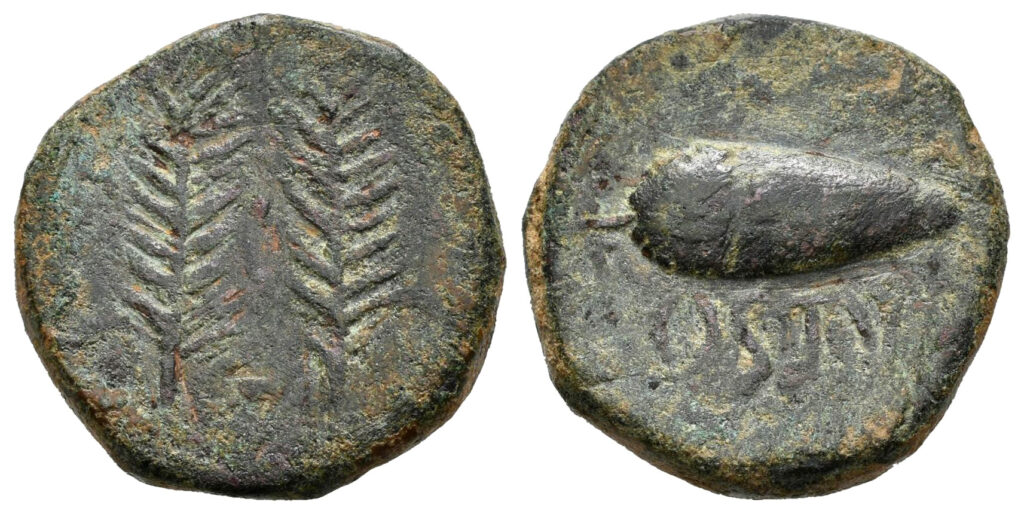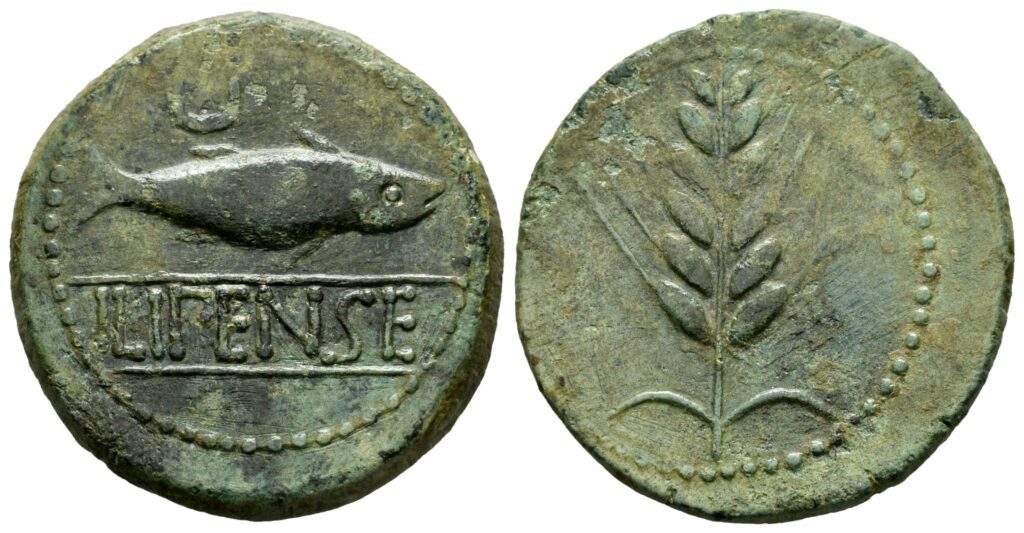The representation of our flora is poorer than the one of the fauna. This is just natural. After all, an animal is a living being that moves around and transmits more emotions than a plant, which is also an organism but more static. This is where the speaking role of the coin comes into play: you get your enemy’s respect by showing him that you dominate a horse or an elephant and that you have the Pegasus or Sphinx by your side, while you cannot expect him to be much impressed by your large number of acorns or palm trees.
I will divide the vegetable representations in three groups. In the first one I will include the plant itself (a tree, a bush, grass, etc), while the second group will be for the products we obtain from the plants, such as the fruit, the flower, the grain, etc. As for the third group, it refers to plants as ornaments.
According to our ancient sources, in our fertile lands the most important crops were those of the wheat, barley and millet, which was also used for making bread and could be stored for over 100 years in our old silos.
Regarding our forests, all of us have heard that legend according to which a squirrel could go from Gibraltar to the Pyrenees from tree to tree. And without touching the ground! This is probably a false legend, although it has been attributed to Strabo by some people. What we cannot deny is that two thousand years ago there was a very large area covered with trees in our peninsula.
GROUP I (TREES, BUSHES, GRASS, ETC.)
Palm tree

The Greek name stands both for palm tree and Phoenician. It was intended to place on record that the issuing authority was Punic, as their alphabet was not understood by other cultures. As a tree, it was represented in mints like those of Cartago Nova, Baria, Tagilit, all of them with a clear Punic style.
The palm as part of a tree can be found in different mints throughout our country, like in Arsa: ACIP-910, Baicipo: C-1, Laelia: ACIP- 2361. Here we can see it together with a sprig. Ugia: ACIP- 2649.
As the palm leaf represents celebration or victory for many different cultures, it may also be carried by a rider in some coins. So, there are many mints including it when representing their victorious riders, such as in Iltirta, Iltirkesken, Sekaisa, Kelse, Turiasu, etc.
Fan Palm
We can find it in the mint from Laelia. We do not consider it a palm leaf because of the layout of the leaves, surrounding the central leaf stack. We can see it in semissis and quadrans of the a.m. mint: C2/4. This is the only native palm from our peninsula. Do not confuse with the palm heart, which is extracted from the tender sprout of another palm trees to be canned and sold in supermarkets. Especially, the palm heart coming from Ecuador, its main producer.
Tree
Described just as a tree by several authors, it can be found standing behind a bull in the mint from Vesci. The engraver’s weak style does not make us think of any tree in particular. But as this mint is in Extremadura, we might consider it is a holm oak, which is so common in that area.
Laurel

We can find it in some denarius of Augustus minted in Caesar Augusta. It can be represented by its branches as in ACIP-4.022 or forming a laurel wreath in the aureus ACIP- 4.024, where it can be found in the obverse and reverse.
Olive tree
According to the Greek mythology, the olive tree was a gift of the goddess Athena to the people from Athens. Despite the large number in our peninsula, it is not easily found in our coins. The same as the laurel, it can be represented by its branches, framing an owl in the fractions preceding the drachmas of Emporion. C-6. In Vill 2: page 157 no. 142 and 144.
Grapevine

We have an interesting representation of this plant in Ulia. It shows the roots of the plant, from which two branches with their fruits emerge forming a sign where it can be read: VLIA. C-1/5.
Other mints show a human figure carrying a bunch of grapes. Irippo: C-5, Orippo in all the cases as in Oset. In Turri. Regina shows the bunch of grapes together with a sprig. C-3.
These examples prove the interest of the mints in showing the quality of their products through their coins. This is the case of the grape, from which the different types of wine, so appreciated by Romans, were obtained.
Wheat sprig

Together with the palm, it is the vegetable element which is the most often represented in our ancient coins. Above all, we can find it in the mints of the South of our peninsula. Sometimes it is shown alone, like in Carmo, Bailo, Iliturgi, Mirtilis, etc. In Mirtiles the sprig in some of the pieces degenerates into a palm or fish bone.
Sometimes we can find two sprigs in parallel, while on many other occasions we can see them framing the mint and forming a well-balanced ensemble, like in Acinipo, Ilipla, Onuba, etc. In some of the pieces of Acinipo we need a leap of faith to affirm that we are in front of a sprig, as in C-3.
It often plays a complementary role, as in Obulco or in Abra. It is always accompanied by a plough. In the sextantal as from Obulco we can see a magnificent piece showing a very well engraved sprig of high quality.
In Lascuta we can find it, decorating an altar with two, three or four sprigs: C-2,3 and 1.
There is a very interesting as from Bailo: C-5, where we can see a sprig behing Melkart’s head. We cannot see the club, maybe it was removed to show that the kind of protection he offered was less warlike and more agricultural.
We can also find it in Vesci as part of an obverse, where it accompanies a male head.
There are so many mints including this element that we think there may have been several reasons to represent it.
GROUP II. PRODUCTS OBTAINED FROM PLANTS.
In this section we include the products offered by the plant (the fruit, the flower, the grain, etc). Some of the mintings do not have the artistic quality we had wished in order to see clearly the artist’s intentions. So, some palms may look like sprigs, or the other way around, or there may be grains which could be seeds, or pineapples looking like custard apples. But the challenge has been accepted by many publications and we can be almost sure of some representations which may look dubious.
Rose
The rose from Rhode, seen from below, deserves the first place in this list, due to its age and beauty. What imagination had those artists! C- 1/5. It can also be found in C-6 and -8 but seen from above. In the mint of Ebusus we have a four-petal rose in C- 29.
Lotus
It can be found in a hemi drachma from Ebusus: C-16, or in a quadrans: C-42. Also, in a drachma from Arse, although it may also be another type of flower: C-21.
Flower with several petals
This is a very schematic representation of any flower with those characteristics. It is a motif which keeps repeating in the Middle Ages. Ebusus: C- 13. (seven petals). Also, one with four points surrounding a central point in C.14, five in C-32 and six in C-27. All of them coming from the same mint.
Pinecone

We refer to the fruit coming from the pine trees, not the tropical pineapple (in Spanish the word “piña” stands for “pinecone” and “pineapple”). Pine nuts must have had a large demand in ancient times, as they were used for sauces and stews. It might have determined the value of the coin. We can find it in the semissis from Olontigi: C- 2 and 3. It can also be seen in the hand of a sitting woman in Irippo: C-1/4.
Acorn

It can be found in all the coins minted in Ostur. ACIP: 2429/2436. Near Villalba del Alcor in the province of Huelva. It is highly probable that there was an emerging pig meat industry in the area. We cannot determine how old this activity was, but in the Greek island of Salamis, which was destroyed in 450 BC, there was a production of cold meat, which has lasted until these days.
Grapes

We cannot see any grapes by themselves, or in isolated units. They are always shown in a bunch, which is why I have included it in the first group as grapevine. In all the series coming from the mint of Acinipo there are some bunches of grapes which look so tasty that you feel like eating them.
Dates
In some coins from Cartago Nova we can see a palm with fruits, which makes me think of some delicious dates that were so abundant in the current Tunisia. In a fraction of a “chalque” (half), C-41, we can see a clear and nice example. The piece of three siculos with a standing horse is even better: C-63.
GROUPO III. DECORATION.
Laurel wreath

The different laurel wreaths we can see on the heads of gods, heroes, warriors… would deserve an extensive article only on this topic, but it is not my intention to do this. So I will just talk about these decorations and add some curiosity.
If there is one laurel wreath, which has drawn my attention in the last few years, it is the as from Laiesken. At first, we thought that there was a headband on the head, but later a very well-preserved piece was found which made us realize that we were in front of a laurel wreath of high quality, which had been obviously made by a great artist.
As a curiosity, we can see it in Lauro on the obverse of C: 10 together with a torques with a snake’s head.
Crown of oak leaves
We can find it in several mints, as in Bilbilis, where it is the central motif on the reverse of the mintings of the Imperial time. In the mintings from Celsa in the times of Augustus, we can find it in the obverse, surrounding Augustus’ bust.
Ivy leaves
They can be found in some fractions prior to drachmas: ACIP- 96 and 97.
Sprig

It is part of the headdress of several female representations. Above all, it can be found in the drachmas from Emporion of the 3rd century BC. This mint stops using the Carthaginian typology, so Persephone, who was Proserpina in the Roman mythology, disappears and is replaced by Arethusa, who has a clear Sicilian influence. It can be found on the reverse of the coins from Valentia, where it is surrounding the central cornucopia.
Shoot
It is a decoration on a bearded head on the obverse of a piece from Sacili: ACIP- 954.
Floral arrangement
The obverse of an as from Tuririicina offers us an interesting floral arrangement consisting of leaves and stems, which we do not dare to define: C-1/3.
Cornucopia

In the mint of Valentia, we have a large ensemble of fruits related to the decorative aspect of this element. We probably find ourselves in front of some pomegranates, which were so abundant in this area.
I finish this part of the work dedicated to the flora, where I have described up to twenty-one elements, with this little contribution to the decorative nature of our flora. Take note that my only intention is offering an entertaining article so that you have a good time with it.
I would like to mention a work, which has been very helpful for me. I am talking about the one published by the team of the Museum of Prehistory of Valencia: FLORA IBÉRICA (Iberian flora). Diputación de Valencia 2010. Please, let me express my sincere gratitude and admiration.

